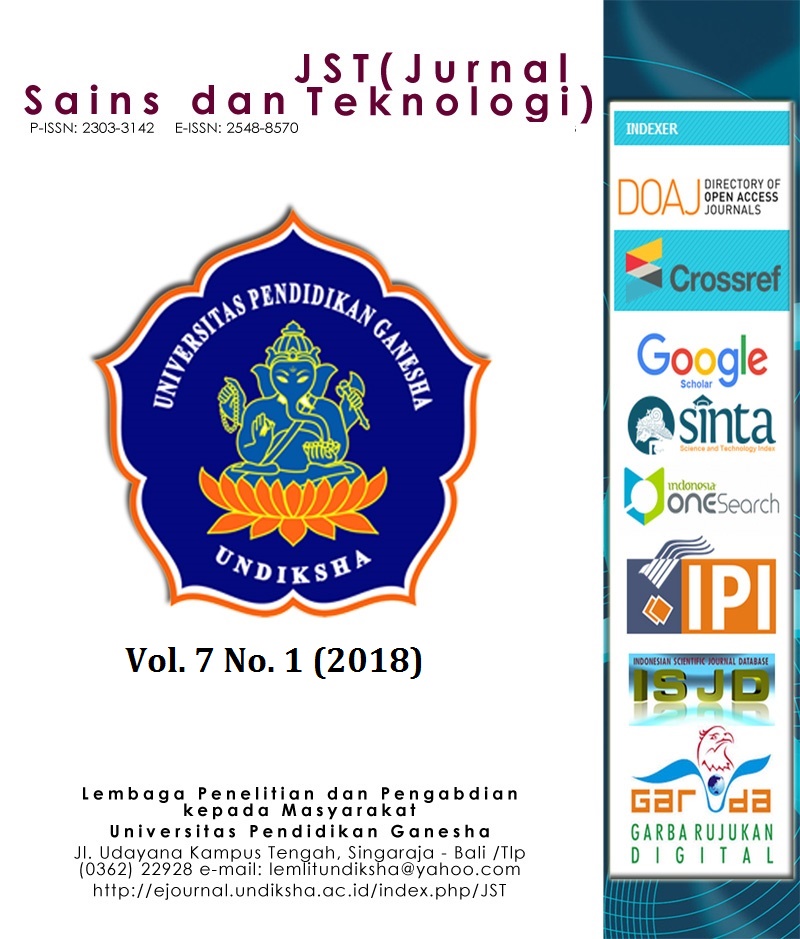Ammonia Determination In Bottled Water Using Spectrophotometer : Comparison Between Nessler And Berthelot Methods
DOI:
https://doi.org/10.23887/jstundiksha.v7i1.13009Kata Kunci:
Berthelot method, Nessler reagent, precision, accuracyAbstrak
Ammonium concentration in bottled drinking water should not exceed 0.15 ppm. National Standardization Agency of Indonesia (BSN) had issued two standard methods for analysis, Nessler (SNI 01-03554-1998) and Berthelot (SNI 01-03554-2006). Both were statistically compared. The first method was much simpler than the second one because the preparation was only by adding the Nessler reagent into the sample. Whereas in the second one, the addition of reagents should be prepared freshly. The variance coefficient of the first method was 3.41% with linearity 0.9995 and recovery was 101.05%. Whereas variance coefficient of second method was 3.64 % with linearity 0.9995 and recovery was 105.62%. Significance test between the methods showed that value of Fexp (1.043) was less than Fcrit (4.284), and value of texp (2.36) was less than tcrit (2.45) in interval of confidence 95%. There was no significant difference between two methodsReferensi
Hasri and Mudasir, Study Of The Effect Of Ethanol Addition And Solution Heating On The Determination Of Ammonia In Water By Indophenol Blue Method, Indonesian J. Chemistry, 2002, vol.2, no. 2, 97-101.
Jeong, H., Park, J., and Kim, H., Determination of NH4+ in Environmental Water with Interfering Substances Using the Modified Nessler Method, J. of Chemistry, vol. 2013, article ID 359217, DOI 10.1155/2013/359217
Loan, D.K., Con, T.H., Hong, T.T. and Mai Ly, L.T., Quick Determination of Ammonia Ions in Water Environment Based on Thymol Color Creating Reaction, Environ. Sciences, 2013, vol. 1, no. 2, pp. 83 - 92
Miller, J.N. and Miller, J. C., 2010, Statistics and Chemometrics for Analytical Chemistry; Sixth edition, Essex : Pearson Education Ltd., England.
Park, G.E, Oh, H.N., and Ahn, S., Improvement of the Ammonia Analysis by the Phenate Method in Water and Wastewater, Bull. Korean Chem. Soc., 2009, vol. 30, no. 9, pp. 2032-2038
Shoji, T. and Nakamura, E., Flow Injection Analysis with Spectrophotometry for Ammonium ion with 1-Naphthol and Dichloroisocyanurate, J. Flow Injection Anal., 2009, vol. 26, no. 1, pp. 37–41.
Tzollas, N.M., Zachariadis, G.A., Anthemidis, A.N. and Stratis, J.A., A New Approach to Indophenol Blue Method for Determination of Ammonium in Geothermal Waters with High Mineral Content, Intern. J. Environ. Anal. Chem., 2010, vol. 90, no. 2, pp. 115–126.
United Nations Office on Drugs and Crime, 2009, Guidance for the Validation of Analytical Methodology and Calibration of Equipment used for Testing of Illicit Drugs in Seized Materials and Biological Specimens, New York : United Nations
Voica, C., Dehelean, A., Iordache, A., Geana, I., Method Validation for Determination of Metals in Soils by ICP-MS, Romanian Reports in Physics, 2012, vol. 64, no. 1, pp. 221–231.
Unduhan
Diterbitkan
Cara Mengutip
Terbitan
Bagian
Lisensi
Authors who publish with the Jurnal Sains dan Teknologi (JST) agree to the following terms:
- Authors retain copyright and grant the journal the right of first publication with the work simultaneously licensed under a Creative Commons Attribution License (CC BY-SA 4.0) that allows others to share the work with an acknowledgment of the work's authorship and initial publication in this journal.
- Authors are able to enter into separate, additional contractual arrangements for the non-exclusive distribution of the journal's published version of the work (e.g., post it to an institutional repository or publish it in a book), with an acknowledgment of its initial publication in this journal.
- Authors are permitted and encouraged to post their work online (e.g., in institutional repositories or on their website) prior to and during the submission process, as it can lead to productive exchanges, as well as earlier and greater citation of published work. (See The Effect of Open Access)
















